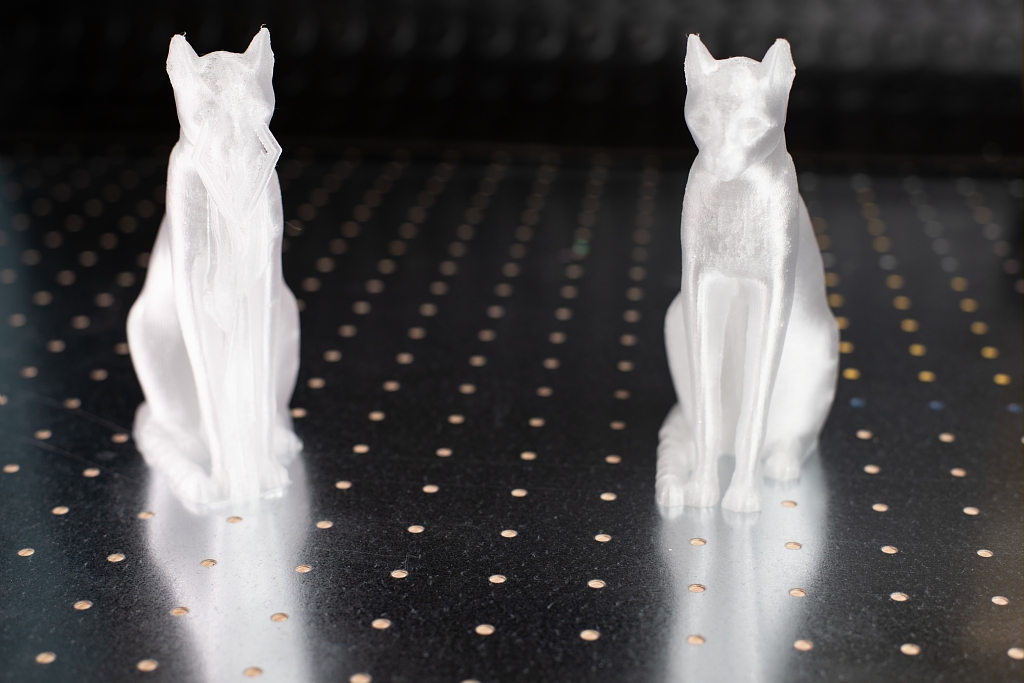
It was at the Formnext 2019 exhibition and conference, held in November last year in Frankfurt, that the world of metal 3D printing discovered the potential of the research carried out by the Inria team MFX. The team announced its R&D partnership with AddUp, a machine manufacturer set up in 2016 by Michelin and the engineering group Fives, in addition to the first innovation to come out of this agreement.
MFX was previously best-known for its IceSL software, which primarily targeted plastic filament technology. With AddUp, a specialist in metal additive manufacturing machines, their algorithms will play an integral role within a new category of processes.
Deposits of material three times finer than a human hair
“We have collaboration projects with a number of industrial partners.”, explains Sylvain Lefebvre, head of MFX and an Inria director of research. “But AddUp opens up unique opportunities given the exceptional quality of their metal 3d printing solutions and the applications being targeted.”
To understand the scope of the innovation presented in Germany, it should be borne in mind that additive manufacturing involves parts being made in successive “slices”. Each slice is manufactured by depositing material (metal, resin, etc.) on top of the previous slice, in much the same way as you would colour in a sheet of paper. The thinnest “lines” are no more than 35 microns wide: a third of the width of a human hair!
Possibilities limited by the preparation software
Just as a pencil can take various different paths when colouring, so deposits of materials take different trajectories, drawing patterns of different shapes, sizes, spacing and orientation. One single slice can be made up of thousands of different trajectories. These will determine the properties of the part (rigidity, porosity, density, tensile strength, colour, etc.), both overall and at a local level, given that each slice may be different from the others.
“With additive manufacturing the possibilities are endless, which is one of the reasons for its rise”, explains Sylvain Lefebvre. “However, we found that the preparation software used to test and validate trajectories in advance was starting to hold us back. If they use up too much memory space and processing time, it becomes very difficult to design and compare multiple manufacturing strategies.”
Five times quicker to calculate trajectories
It was this technological obstacle that MFX and AddUp were successfully able to overcome. Thanks to targeted work aimed at improving algorithms, the trajectory calculations in AddUPTM Manager (the preparation software used by the manufacturer) were made up to five times quicker than the previous version.
“Not only will this save users from minutes to hours, but they will also be able to compare multiple manufacturing strategies more quickly and to select the best one, based on criteria such as productivity or the mechanical properties of the finished part.”
Scientific and technical innovation with its roots in Inria research
The algorithms used are based on MFX research results, that emerged from the SHAPEFORGE project supported by the European Research Council (ERC). These results were made accessible to the wider public via the team’s IceSL software, the result of a second ERC project for industrial transfer. The IceSL software can be used to model objects in 3D, to break them down into slices and to vary physical properties from one slice to the next through precision printing control.
“IceSL, however, is a non-commercial tool that is free to download - it is not an industrial product. Nevertheless, it does reflect the knowledge and expertise of the team, which AddUp and our partners are able to benefit from.”
Moving towards bigger and more complex parts
Aside from being spectacularly quicker, the new version of AddUpManagerTM is changing the world of 3D printing in two ways.
Firstly, it fully supports AddUp with its goal of incorporating trajectory generation into its preparation software, as opposed to its machines, as is the case with many of their competitors. A software program, by nature more flexible, can be used to create more complex parts.
The automotive and aeronautics industries can envision incorporating in parts microstructures akin to sponge, foam or honeycomb structures. This will enable them to make their products lighter. The medical sector can envisage bespoke prosthetics for individual patients, without any notable increase in cost. The design and luxury industry can create objects with unprecedented freedom of shape.
The second major change is that the new software is powerful enough to prepare for the manufacturing of larger objects, without being hampered by the volume of data required during processing. This is crucial, given that the race for size is one of the key challenges in 3D printing. Today the largest parts are around 40-50 cm in size - a few years from now, we will break the metre barrier. AddUp and Inria seem well positioned to take part in this competition, but are unwilling to give away any details on their strategy in this highly competitive field: “Our collaboration is ongoing” is all that Sylvain Lefebvre will say.